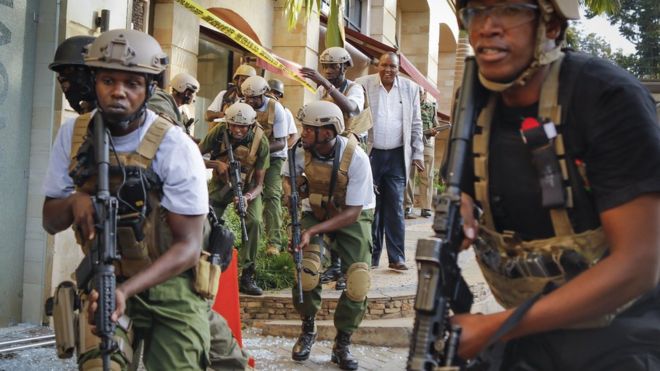Lessons Kenya must learn from DusitD2 attack

After close to four years of calm in urban areas,
Al-Shabaab demonstrated its continued threat to peace in Kenya with the
operation launched in an upscale apartment and restaurant complex in Nairobi.
The gun, grenade and bomb assault will raise inevitable
questions about why the country has been targeted successfully so many times
over the last eight years.
First, it is worth looking at some of the more positive
aspects of Tuesday’s attack.
Between 2011 and 2014, Al-Shabaab seemed to have
succeeded in stretching the cord that holds Kenya together to the limits.
The group deliberately sought to exploit the country’s
ethnic and religious diversity and, in its propaganda, it highlighted these as
offering it a chance of triggering sectarian strife.
“Thank God Kenyan society is divided and facing ethnic
clashes,” said one of the group’s ideologues, Sheikh Mohammed Dulyadeyn, in a
video released in June 2014.
UNITY
He urged militants to increase their attacks in the
country and it was no coincidence that a wave of gun and grenade assaults
targeted at churches followed, although the sectarian fighting Al-Shabaab hoped
to trigger did not materialise.
Kenya has largely managed to reduce regular attacks in
urban areas since 2014, although the Tuesday assault shows that the fight is
far from won.
Most critically, political temperatures in Kenya are now
much lower than they were during the Westgate attack in September 2013.
Wednesday’s united, and clearly coordinated responses by
President Uhuru Kenyatta and Opposition leader Raila Odinga, sent out a message
of national resolve and signaled that Al-Shabaab will not succeed in tearing
the country apart. A second positive factor from this was the significant
improvement in security response and coordination.
PLANNING
As was well-recorded, the response to Westgate by the
security forces was a study in chaos.
Friendly fire incidents, lack of coordination and
multiple delays meant a greater number of casualties drew and sustained adverse
press around the world, with its inevitable effect on critical sectors of the
economy.
The response to the Dusit assault was swifter and much
better coordinated.
It demonstrated that efforts to improve inter-agency
cooperation in the security sector, under the overall ambit of the National
Counter Terrorism Centre (NCTC), have borne fruit.
On the ground, the commander was Douglas Kanja, the
General Service Unit Commandant. The security forces saved dozens of lives.
SECURITY GAPS
Communication was also much better and measured than
during Westgate.
The fact that many Nairobians carried on with business as
usual on Wednesday was a big improvement on 2013 when the nation felt under
siege.
Despite these positive elements, there will be inevitable
questions about why this attack was allowed to occur.
Why does Kenya experience far more attacks than other
troop-contributing countries in Somalia including Uganda, Burundi, Djibouti and
Ethiopia or Tanzania, a country which, although it has not sent troops to
Somalia, has been battling its own domestic militants with suspected ties to
Al-Shabaab?
Theories abound. It is true that Kenya is seen as a base
and magnet for Western countries, explaining recent and previous attacks
including the 1998 embassy bombings and the Paradise Hotel assault in 2002.
VULNERABLE
It is also true that Kenya is one of the more open
societies in Africa, partially explaining the relative ease with which people
can move in and out of the country.
However, these explanations are only a partial accounting
of the reasons the country suffers repeatedly and it will be wise to engage in
an exhaustive post-mortem of events at Dusit to understand how the attackers
and planners succeeded.
This was a complex operation. It involved not just
assembling the arsenal of guns and bullets but also putting together a suicide
bomb and suspected car bombs. There should be a thorough examination of why
this elaborate process escaped the attention of the security agencies. Moreover,
questions should be confronted on border security.
On several occasions, militants have slipped through
Kenya’s porous border with Somalia and perpetrated attacks on Kenyan soil.
CULTURE
Ethiopia shares an even longer border with Somalia. But
its security officers and border agents are said to be much stricter, more
thorough and less corruptible than their Kenyan counterparts. This is an
inconvenient issue that needs to be confronted.
Also, perhaps because of the leftist/Marxist backgrounds
of the states in Tanzania and Ethiopia, there is a greater culture there of
community-level intelligence gathering that makes it much harder for terrorists
to operate.
What can Kenya learn from this? Was the Nyumba Kumi (10
houses) initiative abandoned too early or at least not sufficiently implemented
in urban areas?
Finally, although there are understandable downsides to
this, it is still worth debating whether the Ugandan model where armed security
officers secure key buildings, including civilian outlets, is worth emulating.
PREVENTION
It is true that not all terrorist plots can be thwarted.
The ideology that feeds mindless extremism will be with us for a long time. Kenya
should certainly continue with elements of what has worked over the last four
years: containment and thwarting and limiting attacks as much as possible.
But there should also be consideration of other tweaks to
security strategy to stop another Dusit. All this should be done within a
rule-of-law framework and it was heartening to hear President Kenyatta open his
remarks yesterday by saying this is a country of laws.
Crackdowns against whole communities must be avoided.
Al-Shabaab should not change what Kenya is. The group has little chance of
success because its ideology is warped and rejected by all but a small minority.
Still, Kenya should invest more in ensuring gains enjoyed
between 2014 and today are not reversed by the Dusit attack.
Material: Daily Nation, Kenya.
Comments
Post a Comment